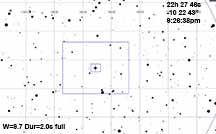

This is a wide path event, and nominally good rank. The centerline goes pretty much over downtown Santa Cruz and also over Karl. The SouthBay people are also inside the northern limit of the path, so we could get a decent shape and astrometry for this one. The only trouble is the altitude. Only 9 degrees up in the SE, in Aquarius. The sun is at -16 so should be no problem, but we'll have to ID the field while the stars are rather well extincted. I tried an event like this from Devil's Slide south of San Francisco last year, and failed. However, strong winds and oncoming headlights from Hwy 1 were a real problem. You'll need to find a spot with a very good low horizon to be able to ID the field early.
This will also be a test to see the feasibility of the Didymos occultation next month, which is a half magnitude dimmer, but at the same altitude and only lasts 0.1s and likely will be lost in scintillation. Tonight's event should be much easier to at least get the data, because the duration is a max=2.0s.
Extinction: Compared to a star at a good high 60 degrees, this star will be 1.4 magnitudes dimmer in V, a bit better in R. Say 1.3 mag in W band. So that means it will look like an 11.1 star at high altitude. However, that should be good enough for doing this at 2x, or 4x at worst.
Sites: Karl's place is right on the same track as "the Berm" so the Berm should be avoided. The horizon at the Bike Crossing upper UCSC should have a 9 degree horizon, from the east side spot. Llama Ranch Lane in Cave Gulch would also be good. But to get better coverage, I'd recommend to Kirk that he try it from near the Lighthouse, if possible. Which is right on the centerline.
 |
 |
Kirk observed and recorded from West Cliff near Stockton Rd, at my suggestion. He got a ~2s positive. I observed from the Pogonip Overlook on the UCSC campus. We both had a challenge finding the target at such low altitude through the haze and marine layer, but succeeded. Karl tried from "water truck turn" but the low clearance did not give enough time to ID the star field.
I got a very solid high accuracy solution of 1.145 sec duration. I had only one star to reference or track with, the bright star just above the VTI numerals. It was good enough. I set the metric interval, minimized the deviation from flatness first with smoothing, and then with offset in time.
 |
 |
 |
 |
The moon was in the heart of Scorpius at this time |
magDrop report: percentDrop: 93.2 magDrop: 2.918 +/- 0.502 (0.95 ci)
DNR: 3.60
D time: [04:26:36.7832]
D: 0.6800 containment intervals: {+/- 0.0078} seconds
D: 0.9500 containment intervals: {+/- 0.0201} seconds
D: 0.9973 containment intervals: {+/- 0.0401} seconds
R time: [04:26:37.9325]
R: 0.6800 containment intervals: {+/- 0.0078} seconds
R: 0.9500 containment intervals: {+/- 0.0201} seconds
R: 0.9973 containment intervals: {+/- 0.0401} seconds
Duration (R - D): 1.1493 seconds
Duration: 0.6800 containment intervals: {+/- 0.0115} seconds
Duration: 0.9500 containment intervals: {+/- 0.0256} seconds
Duration: 0.9973 containment intervals: {+/- 0.0481} seconds
 |
 |
 |
 |
 |
 |